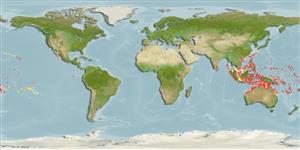Issue
The synonym P. quadrispinosa (Weber, 1913) is valid and redescriberd according to Johnson & White, 2012 (Ref. 90268).
Environment: milieu / climate zone / depth range / distribution range
Ekologi
laut berasosiasi dengan karang; kisaran kedalaman 0 - 100 m (Ref. 128797). Tropical; 30°N - 24°S
Indo-West Pacific: India and Sri Lanka to Tonga (Ref. 53797); , Ryukyu Islands and the Great Barrier Reef to the Marshall Islands and Samoa. Recently recorded from
Size / Weight / umur
Maturity: Lm ? range ? - ? cm
Max length : 24.0 cm TL jantan/; (Ref. 48636)
Duri punggung (Keseluruhan (total)): 4 - 5; duri punggung lunak (Keseluruhan (total)): 20-21; Duri dubur 1; Sirip dubur lunak: 17. A row of small blackish spots in outer third of anal fin (Ref 42740). Males develop a conspicuous ocellus on each side of the nape (Ref. 1602). Young are best identified by the patch of small spots on the cheek that usually remains evident in adults (Ref. 48636).
Inhabits both clear lagoon and seaward reefs, in areas of open sand and rubble as well as on rocky surfaces between coral heads. Also in current prone channels (Ref. 48636). May be found solitary or form small groups (Ref. 90102).
Life cycle and mating behavior
Kematangan | Reproduksi, perkembang biakan | Pemijahan | telur-telur | Fecundity | Larva
Randall, J.E., G.R. Allen and R.C. Steene, 1990. Fishes of the Great Barrier Reef and Coral Sea. University of Hawaii Press, Honolulu, Hawaii. 506 p. (Ref. 2334)
Status IUCN Red List (Ref. 130435)
ancaman kepada manusia
Harmless
penggunaan manusia
informasi lanjut
Nama-nama umumSinonim (persamaan)metabolismePemangsaEkotoksikologiReproduksi, perkembang biakanKematanganPemijahanSpawning aggregationFecunditytelur-telurpekembangan telor
AcuanBudidaya airprofil budidaya airStrainGenetikaElectrophoresesDiturunkanPenyakit-penyakitPengolahanNutrientsMass conversion
mitraGambarStamps, Coins Misc.Suara-suaraCiguateraKecepatanTipe renangArea insangOtolithsOtakPenglihatan / visi
Alat, peralatan
laporan khas
muat turun XML
Sumber internet
Estimates based on models
Preferred temperature (Ref.
123201): 26.1 - 29, mean 28 °C (based on 586 cells).
Phylogenetic diversity index (Ref.
82804): PD
50 = 0.5000 [Uniqueness, from 0.5 = low to 2.0 = high].
Bayesian length-weight: a=0.00692 (0.00311 - 0.01538), b=3.06 (2.88 - 3.24), in cm total length, based on LWR estimates for this Genus-body shape (Ref.
93245).
Trophic level (Ref.
69278): 3.6 ±0.4 se; based on size and trophs of closest relatives
Generation time: 1.4 ( na - na) years. Estimated as median ln(3)/K based on 1
growth studies.
Daya lenting (Ref.
120179): Tinggi, Waktu penggandaan populasi minimum kurang dari 15 bulan (Preliminary K or Fecundity.).
Fishing Vulnerability (Ref.
59153): Low vulnerability (18 of 100).
Nutrients (Ref.
124155): Calcium = 87.2 [47.6, 133.7] mg/100g; Iron = 0.685 [0.432, 1.101] mg/100g; Protein = 18.2 [15.9, 20.1] %; Omega3 = 0.0982 [, ] g/100g; Selenium = 36.4 [19.8, 69.6] μg/100g; VitaminA = 70.1 [25.2, 189.7] μg/100g; Zinc = 1.4 [1.0, 2.0] mg/100g (wet weight);
